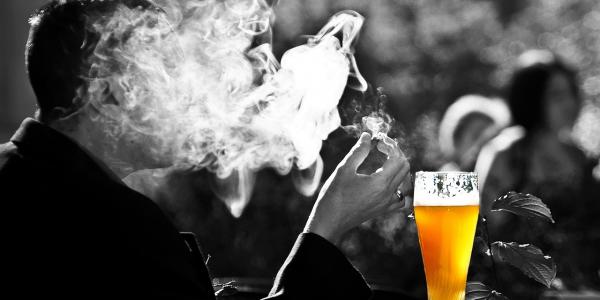Starting to Think About Drinking
.png)
What counts as "one drink"? All drinks are not created equal.
It’s funny – you’d think it would be easy to figure out how much you typically drink to see if you have a problem or not. But, as soon as you start thinking about it, you start to run into some questions that aren’t so simple to answer.
For example, if you’re counting the number of drinks, what actually counts as “one drink”? How much alcohol is in that one drink? Who decided that, anyway? And, as long as we’re at it, how much drinking actually makes up “a problem”? Most people drink as much as I do, don’t they? Why does it even matter if no one is getting hurt?
Great questions. And, as you start to talk about these questions with friends and family, you may run across some common misconceptions about drinking and alcohol use. This article lets you explore some of these questions, providing facts based on top-shelf research and years of data.
Where to begin?
To really begin thinking about your drinking, you probably should start with an understanding of what makes up a single "standard" drink.
When you start to think about your drinking, you’ll want to start out by having a method of figuring out how many drinks you typically drink.
To do this, you’ll need to know one thing -- what makes up "one drink"? Seems like a simple question, doesn’t it? You might say that one beer is one drink, or one glass of wine, or even a single shot of hard liquor. But, how big is that beer? What kind of beer is it? How high did you pour that glass of wine? How much alcohol is in that shot?
Believe it or not, there actually is a standardized way of measuring "one drink."
Defining a “Standard Drink”
In the United States, a standard drink is any drink that contains 0.6 fluid ounces (14 grams) of pure alcohol (U.S. Department of Health & Human Services).
What affects the individual is the amount of actual alcohol in the drink and not the type of drink itself. It doesn’t matter whether you drink shots of hard liquor, a bottle of beer, or “just a glass of wine” – the result is the same if you are drinking the same amount of pure alcohol. That means that drinking one glass of wine is the same as having one shot of whiskey. Each one counts as “one drink.”
The Strength of a Drink
Another complicating factor is that the alcoholic content in the same types of drinks can actually vary quite a bit.
One beer is not always just one beer. The number of drinks you have when you drink "a beer" depends entirely on the percentage of alcohol per volume for that kind of beer. For example, a 12 oz. bottle of Labatt Blue contains about 5% alcohol, which is one standard drink. The same size bottle of Bell’s Expedition Stout contains 10.5% alcohol. That's more than double! So, having one Bell’s is like having two Labatts, in terms of alcohol content. Drink two of them in one night, and you've really had four drinks already. Thus, two beers of the same size are not necessarily equal!
"I just had one glass of wine. Why do I feel so tipsy?" One glass of wine might not really be one drink. Standard table wines, reds, and whites typically have 10 to 12% alcohol content. But, these days wineries are getting pressure to intensify their flavors, which means riper grapes. That means that many wines have higher alcohol content. Some Chardonnays, Pinots, and Merlots can get as high as 15%. Zinfendels can have as much as 20% alcohol.
Hard liquors can really vary a lot. While standard liquors like rum, whiskey, tequila, or vodka tend to contain 40% alcohol, some contain much more than that. For example, Jack Daniel's contains about 40% alcohol by volume, while Booker's (made by Jim Beam Distilling) contains 62% alcohol! Drinking one shot of Booker's is like drinking one and a half shots of Jack Daniel's, or 1.5 standard drinks. Drinking two shots is three standard drinks.
Mixed drinks can get even more confusing. A rum and coke probably has enough rum to equal just one standard drink, but depending on your bartender, you could get as much as two or three drinks worth of rum. A Long Island Iced Tea could have as many as five shots of different kinds of alcohol, which is the same as five drinks in one glass!
Don't Forget About Size!
The other thing to pay attention to is the size of your drink. You might order a large glass of wine thinking that you’re getting a bargain, but the amount of alcohol in the large wine glasses can measure up to one-third of a bottle!
Using the Standard Drink Measure
Now that you know what a standard drink is, you can use that to figure out how much you really drink.
What is my Drinking Pattern?
The following questionnaire comes from the National Institute of Alcohol Abuse and Alcoholism's (NIAAA's) website, Rethinking Drinking. Follow the link, Answer the Questions, then select "Click for Feedback" to find how your drinking patterns compare to those of other adults in the U.S.
Once you are aware of your drinking pattern it might be time to take a look at low-risk as well as high-risk guidelines.
References
U.S. Department of Health & Human Services. National Institute of Health. National Institute on Alcohol Abuse and Alcoholism. Rethinking Drinking: Alcohol & your health. Retrieved from https://www.rethinkingdrinking.niaaa.nih.gov/How-much-is-too-much/What-counts-as-a-drink/Whats-A-Standard-Drink.aspx
Related Articles

Dependency
If you drink too much for too long, you can become dependent, or physically addicted, to alcohol.

Risks to Psychological Health & Appearance
Drinking over the recommended limits can increase the risk to your psychological well-being.

Immediate & Long Term Health Risks
Drinking over the recommended limits can have immediate as well as long term health risks.






